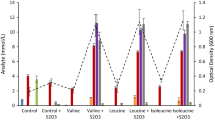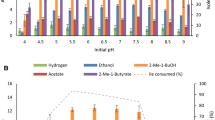Abstract
The pathway of fermentative benzoate degradation by the syntrophically fermenting bacterium Syntrophus gentianae was studied by measurement of enzyme activities in cell-free extracts. Benzoate was activated by a benzoate-CoA ligase reaction, forming AMP and pyrophosphate, which was subsequently cleaved by a membrane-bound proton-translocating pyrophosphatase. Glutaconyl-CoA (formed from hypothetical pimelyl-CoA and glutaryl-CoA intermediates) was decarboxylated to crotonyl-CoA by a sodium-ion-dependent membrane-bound glutaconyl-CoA decarboxylase, a biotin enzyme that could be inhibited by avidin. The overall energy budget of this fermentation could be balanced only if the dearomatizing reduction of benzoyl-CoA is assumed to produce cyclohexene carboxyl-CoA rather than cyclohexadiene carboxyl-CoA, although experimental evidence of this reaction is still insufficient. With this assumption, benzoate degradation by S. gentianae can be balanced to yield one-third to two-thirds of an ATP unit per benzoate degraded, in accordance with earlier measurements of whole-cell energetics.
Similar content being viewed by others
Author information
Authors and Affiliations
Additional information
Received: 5 August 1998 / Accepted: 18 February 1999
Rights and permissions
About this article
Cite this article
Schöcke, L., Schink, B. Energetics and biochemistry of fermentative benzoate degradation by Syntrophus gentianae. Arch Microbiol 171, 331–337 (1999). https://doi.org/10.1007/s002030050718
Issue Date:
DOI: https://doi.org/10.1007/s002030050718




